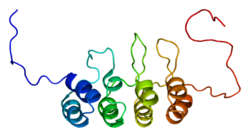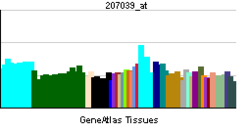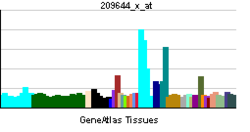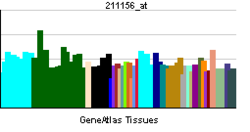| Cyclin-dependent kinase inhibitor 2a p19Arf N-terminus | |||||||||
|---|---|---|---|---|---|---|---|---|---|
 Solution structure of the n-terminal 37 amino acids of the mouse arf tumor suppressor protein | |||||||||
| Identifiers | |||||||||
| Symbol | P19Arf_N | ||||||||
| Pfam | PF07392 | ||||||||
| InterPro | IPR010868 | ||||||||
| SCOP2 | 1hn3 / SCOPe / SUPFAM | ||||||||
| |||||||||
p16 (also known as p16INK4a, cyclin-dependent kinase inhibitor 2A, CDKN2A, multiple tumor suppressor 1 and numerous other synonyms), is a protein that slows cell division by slowing the progression of the cell cycle from the G1 phase to the S phase, thereby acting as a tumor suppressor. It is encoded by the CDKN2A gene. A deletion (the omission of a part of the DNA sequence during replication) in this gene can result in insufficient or non-functional p16, accelerating the cell cycle and resulting in many types of cancer.[5][6][7]
p16 can be used as a biomarker to improve the histological diagnostic accuracy of grade 3 cervical intraepithelial neoplasia (CIN). p16 is also implicated in the prevention of melanoma, oropharyngeal squamous cell carcinoma, cervical cancer, vulvar cancer and esophageal cancer.
p16 was discovered in 1993. It is a protein with 148 amino acids and a molecular weight of 16 kDa that comprises four ankyrin repeats.[8] The name of p16 is derived from its molecular weight, and the alternative name p16INK4a refers to its role in inhibiting cyclin-dependent kinase CDK4.[8]
- ^ a b c GRCh38: Ensembl release 89: ENSG00000147889 – Ensembl, May 2017
- ^ a b c GRCm38: Ensembl release 89: ENSMUSG00000044303 – Ensembl, May 2017
- ^ "Human PubMed Reference:". National Center for Biotechnology Information, U.S. National Library of Medicine.
- ^ "Mouse PubMed Reference:". National Center for Biotechnology Information, U.S. National Library of Medicine.
- ^ "Entrez Gene: CDKN2A cyclin-dependent kinase inhibitor 2A (melanoma, p16, inhibits CDK4)".
- ^ Nobori T, Miura K, Wu DJ, Lois A, Takabayashi K, Carson DA (April 1994). "Deletions of the cyclin-dependent kinase-4 inhibitor gene in multiple human cancers". Nature. 368 (6473): 753–756. Bibcode:1994Natur.368..753N. doi:10.1038/368753a0. PMID 8152487. S2CID 13199401.
- ^ Stone S, Jiang P, Dayananth P, Tavtigian SV, Katcher H, Parry D, et al. (July 1995). "Complex structure and regulation of the P16 (MTS1) locus". Cancer Research. 55 (14): 2988–2994. PMID 7606716.
- ^ a b Serrano M, Hannon GJ, Beach D (December 1993). "A new regulatory motif in cell-cycle control causing specific inhibition of cyclin D/CDK4". Nature. 366 (6456): 704–707. Bibcode:1993Natur.366..704S. doi:10.1038/366704a0. PMID 8259215. S2CID 4368128.







